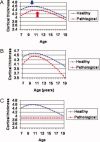Childhood psychiatric disorders as anomalies in neurodevelopmental trajectories
- PMID: 20496382
- PMCID: PMC6870870
- DOI: 10.1002/hbm.21028
Childhood psychiatric disorders as anomalies in neurodevelopmental trajectories
Abstract
Childhood psychiatric disorders are rarely static; rather they change over time and longitudinal studies are ideally suited to capture such dynamic processes. Using longitudinal data, insights can be gained into the nature of the perturbation away from the trajectory of typical development in childhood disorders. Thus, some disorders may reflect a delay in neurodevelopmental trajectories. Our studies in children with attention-deficit/hyperactivity disorder (ADHD) suggest that cortical development is delayed with a rightward shift along the age axis in cortical trajectories, most prominent in prefrontal cortical regions. Other disorders may be characterized by differences in the velocity of trajectories: the basic shape of neurodevelopmental curves remains intact, but with disrupted tempo. Thus, childhood onset schizophrenia is associated with a marked increase during adolescence in the velocity of loss of cerebral gray matter. By contrast, in childhood autism there is an early acceleration of brain growth, which overshoots typical dimensions leading to transient cerebral enlargement. Finally, there may be more profound deviations from typical neurodevelopment, with a complete "derailing" of brain growth and a loss of the features which characterize typical brain development. An example is the almost complete silencing of white matter growth during adolescence of patients with childhood onset schizophrenia. Adopting a longitudinal perspective also readily lends itself to the understanding of the neural bases of differential clinical outcomes. Again taking ADHD as an example, we found that remission is associated with convergence to the template of typical development, whereas persistence is accompanied by progressive divergence away from typical trajectories.
(c) 2010 Wiley-Liss, Inc.
Figures




Similar articles
-
New insights into attention-deficit/hyperactivity disorder using structural neuroimaging.Curr Psychiatry Rep. 2009 Oct;11(5):393-8. doi: 10.1007/s11920-009-0059-0. Curr Psychiatry Rep. 2009. PMID: 19785981 Review.
-
Whole Brain White Matter Tract Deviation and Idiosyncrasy From Normative Development in Autism and ADHD and Unaffected Siblings Link With Dimensions of Psychopathology and Cognition.Am J Psychiatry. 2021 Aug 1;178(8):730-743. doi: 10.1176/appi.ajp.2020.20070999. Epub 2021 Mar 17. Am J Psychiatry. 2021. PMID: 33726525
-
Longitudinal mapping of cortical thickness and clinical outcome in children and adolescents with attention-deficit/hyperactivity disorder.Arch Gen Psychiatry. 2006 May;63(5):540-9. doi: 10.1001/archpsyc.63.5.540. Arch Gen Psychiatry. 2006. PMID: 16651511
-
Developmental trajectories of brain volume abnormalities in children and adolescents with attention-deficit/hyperactivity disorder.JAMA. 2002 Oct 9;288(14):1740-8. doi: 10.1001/jama.288.14.1740. JAMA. 2002. PMID: 12365958
-
Review of neuroimaging studies of child and adolescent psychiatric disorders from the past 10 years.J Am Acad Child Adolesc Psychiatry. 2000 Jul;39(7):815-28. doi: 10.1097/00004583-200007000-00010. J Am Acad Child Adolesc Psychiatry. 2000. PMID: 10892223 Review.
Cited by
-
Annual research review: Optimal outcomes of child and adolescent mental illness.J Child Psychol Psychiatry. 2015 Mar;56(3):324-41. doi: 10.1111/jcpp.12371. Epub 2014 Dec 12. J Child Psychol Psychiatry. 2015. PMID: 25496295 Free PMC article. Review.
-
Trajectories of cerebral cortical development in childhood and adolescence and adult attention-deficit/hyperactivity disorder.Biol Psychiatry. 2013 Oct 15;74(8):599-606. doi: 10.1016/j.biopsych.2013.04.007. Epub 2013 May 28. Biol Psychiatry. 2013. PMID: 23726514 Free PMC article.
-
Socio-Emotional Development Following Very Preterm Birth: Pathways to Psychopathology.Front Psychol. 2016 Feb 12;7:80. doi: 10.3389/fpsyg.2016.00080. eCollection 2016. Front Psychol. 2016. PMID: 26903895 Free PMC article. Review.
-
Quantification of brain proton longitudinal relaxation (T1 ) in lithium-treated and lithium-naïve patients with bipolar disorder in comparison to healthy controls.Bipolar Disord. 2021 Feb;23(1):41-48. doi: 10.1111/bdi.12878. Epub 2019 Dec 2. Bipolar Disord. 2021. PMID: 31755171 Free PMC article.
-
Alterations in Task-Related Brain Activation in Children, Adolescents and Young Adults at Familial High-Risk for Schizophrenia or Bipolar Disorder - A Systematic Review.Front Psychiatry. 2020 Jul 10;11:632. doi: 10.3389/fpsyt.2020.00632. eCollection 2020. Front Psychiatry. 2020. PMID: 32754058 Free PMC article.
References
-
- Barkley RA ( 1997): Behavioral inhibition, sustained attention, and executive functions: Constructing a unifying theory of ADHD. Psychol Bull 121: 65–94. - PubMed
-
- Beacher F, Daly E, Simmons A, Prasher V, Morris R, Robinson C, Lovestone S, Murphy K, Murphy DGM ( 2009): Alzheimer's disease and Down's syndrome: An in vivo MRI study. Psychol Med 39: 675–684. - PubMed
-
- Bucan M, Abrahams BS, Wang K, Glessner JT, Herman EI, Sonnenblick LI, Alvarez Retuerto AI, Imielinski M, Hadley D, Bradfield JP, Kim C, Gidaya NB, Lindquist I, Hutman T, Sigman M, Kustanovich V, Lajonchere CM, Singleton A, Kim J, Wassink TH, McMahon WM, Owley T, Sweeney JA, Coon H, Nurnberger JI, Li M, Cantor RM, Minshew NJ, Sutcliffe JS, Cook EH, Dawson G, Buxbaum JD, Grant SFA, Schellenberg GD, Geschwind DH, Hakonarson H ( 2009): Genome‐wide analyses of exonic copy number variants in a family‐based study point to novel autism susceptibility genes. PLoS Genet 5: e1000536. - PMC - PubMed
Publication types
MeSH terms
LinkOut - more resources
Full Text Sources
Medical

